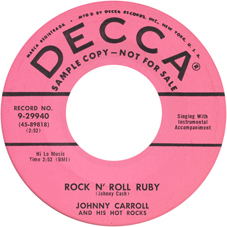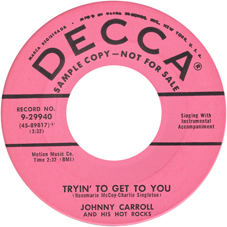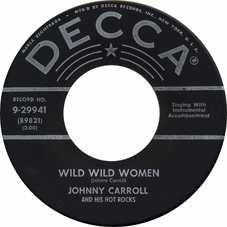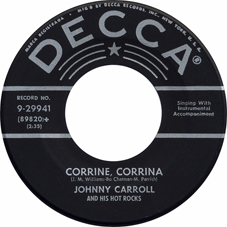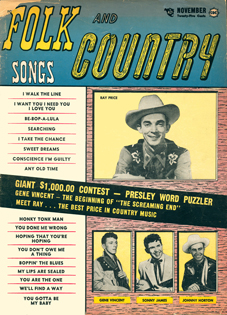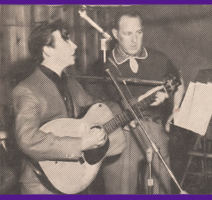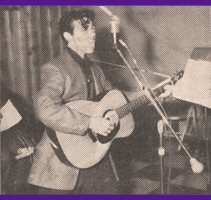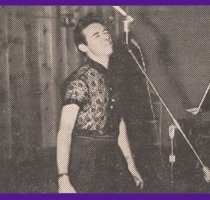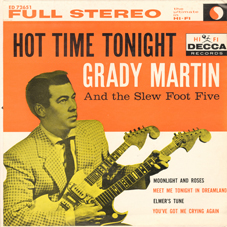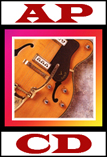In these lame techno-rap-garbage days, they sure deserve another spin - or two !
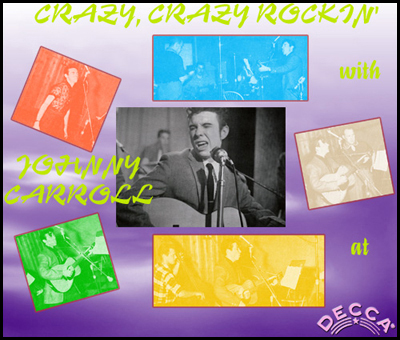
When
I look back, I recall that I first heard of Johnny Carroll almost a decade
after having played my first records by Gene Vincent. In the '70s, Johnny was
rediscovered largely thanks to the British 'Rare Rockabilly' series of albums and after Ronny Weiser
signed him to his Rollin' Rock label, he enjoyed a fabulous comeback. The July
1980 issue of Goldmine Magazine carried the best piece ever written on Johnny
- from the pen of noted collector & musician, John Blair. One of Carroll's best-known compositions, 'Black Leather Rebel', cut in Texas in 1974, was a vibrant
homage to Gene Vincent - an influence already palpable
in previous recordings such as 'The Swing' (WB F 5042, 1959) on which former
Blue Caps, Grady Owen (bass) and Howard Reed (lead guitar), played.
However,
much to my surprise, I discovered that Johnny Carroll had begun recording before his Virginian hero ! Gene cut his first Capitol session in Nashville on May
4, 1956, at Owen Bradley's Studio, exactly one week after Johnny's two
Decca sessions at the same location ! Did the two men meet down there ? I don't
know but I don't think so. As a result, Johnny showed as much originality in
the studio as Gene would a few days afterwards - quite a feat since Johnny
had to rely on studio musicians he didn't even know. But producer Paul Cohen
(not a huge R'n'R fan, though, you know ! He was about to put the tag of 'no-talent' on Buddy Holly) called the right guys. Harold Bradley was on
rhythm guitar, Bob Moore on double bass and Farris Coursey on drums - plus Grady
Martin on lead guitar, who, having almost nobody to copy at the time, literally
invented a plethora of licks that still resonate 50+ years later. The band was to be called 'The Hot Rocks' on the record labels ! Sadly, Grady
passed away on December 3, 2001.
On April 25,
1956, Johnny laid down 'Crazy, Crazy Lovin', 'Tryin' To Get To You' and 'Rock'n'Roll
Ruby' ; the next day, he recorded the ultra-frantic 'Hot Rock', 'Corrine, Corrina' (the best version, according to Yours Truly) and 'Wild, Wild Women'. Johnny's
vocal was way over-the-top but that was precisely what was needed for that stuff.
He didn't like the kind of pseudo Sun-style echo that Cohen achieved during
the sessions ; in retrospect, it wasn't bad at all. Grady Martin largely contributed
to shake up Bradley's Barn (as the studio was then known) with his astonishing
breaks played - that's interesting - on a double neck Bigsby guitar, most probably
derived from the famous Paul Bigsby-Merle Travis solid body axe designed by
both men in '47/'48. He would soon work his magic on countless classics by Johnny Horton, Buddy holly, The Rock'n'Roll Trio, Don Woody... At the same time, on the West Coast, Joe
Maphis was using his double neck Mosrite on rockabilly recordings by Skeets
Mc Donald, The Collins Kids and Wanda Jackson.
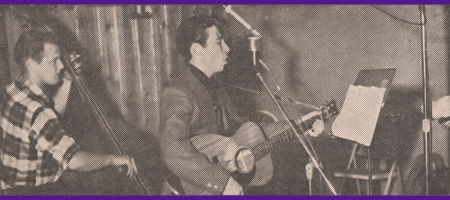
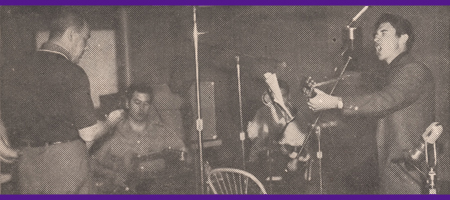
I'm sure that
many of you will delight at the sight of the photos on the left and above- the five of which appeared
ONLY in the November 1956 issue of 'Folk & Country Songs' (US mag), and now on my site. The accompanying article, titled 'Johnny Carroll - Rockin' Country Boy' was short but surprisingly positive. These
five shots constitute the only visual counterpart to Johnny Carroll's
Decca recordings. One can feel the tension and the urgency of the music created
that day (we simply don't know exactly which session it was).
Those brave early rockabilly cats must have had a real tough time in the studio with producers who didn't care for the new music. Grady Martin and Paul Cohen can be seen : the former seated, the latter trying
to keep time while Johnny's cutting loose ! If you look closely (and I know
you will), you'll notice the two mikes that Paul Cohen put together in front
of Johnny Carroll, probably in order to create that echo effect. Then, there's a young Bob Moore playing his bass with cigarette in hand ! You'll also
find that Johnny's likeness to Gene Vincent is absolutely striking. And we can
safely state now that Johnny used his own rhythm guitar on some tracks.
One of the
original captions read : 'mussed hair and pained expression indicate a 'give
all' session by Johnny'. Another read : 'He gives meaning to all his tunes'. The writer of the article was adamant that 'the executives
up at Decca Records were really buzzin' about their new discovery' ; indeed, they released the six gems in rapid succession but alas, Carroll's
three '45s sank almost without a trace in 1956. Yet, they must have made enough noise for Johnny to be chosen for the 'Rock, Baby, Rock It' movie the next year ; this and the rest of his career will be discussed in another page.
Next, all you have to do is dip into your collection and pull out those Johnny
Carroll Decca singles (or the ultra rare French EP released on CID 100.569 which compiled four cuts out of the six) : they represent rockabilly at its best.
| Decca 29940 (US) | Tryin' To Get To You */ Rock'n'Roll Ruby * |
| Decca 29941 (US) | Corrine, Corrina */ Wild, Wild Women * |
| Decca 30013 (US) | Crazy, Crazy Lovin' */ Hot Rock * |
| MCA MCFM 2697 (UK) | 'Rare Rockabilly' (featuring tracks marked *) |
| MCA MCFM 2789 (UK) | 'Rare Rockabilly - Volume II' (featuring tracks marked *) |
| CHARLY CR 30241 (UK) | 'Crazy Hot Rock' (featuring the Decca & Sun stuff) |
| BEAR FAMILY BCD 15623 | 'That'll Flat Git It - Vol. 2' (featuring all six Decca cuts by Johnny) |
| BEAR FAMILY BCD 15928 | 'Rock Baby, Rock It' (feat. all the Deccas + demos, Sun, WB & more) |
© PAUL VIDAL * Privas, France * 2002 - 2024


